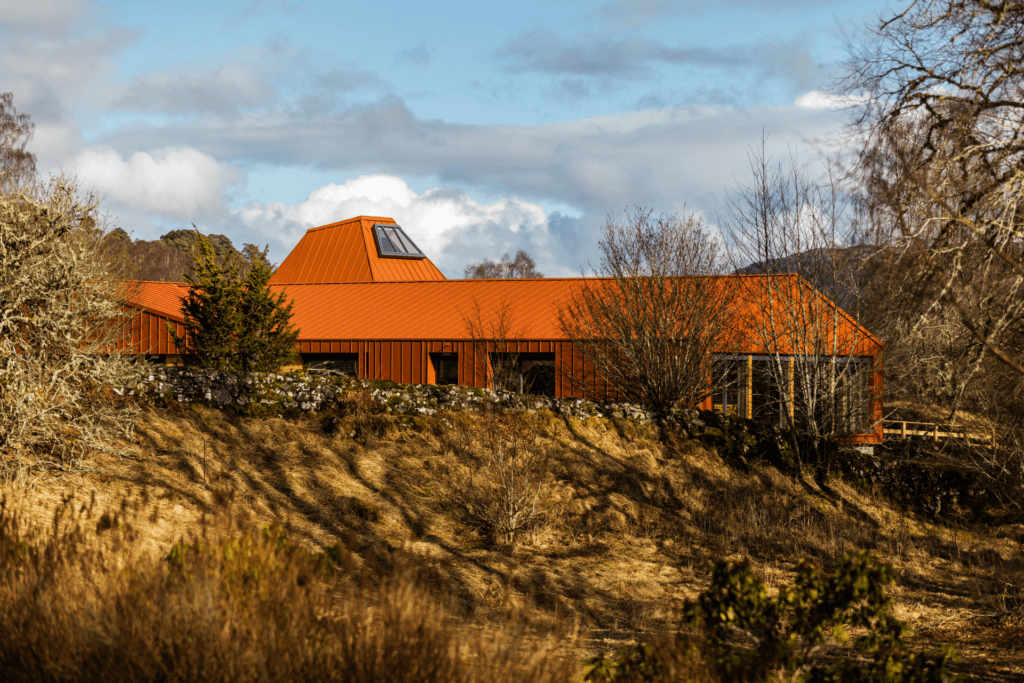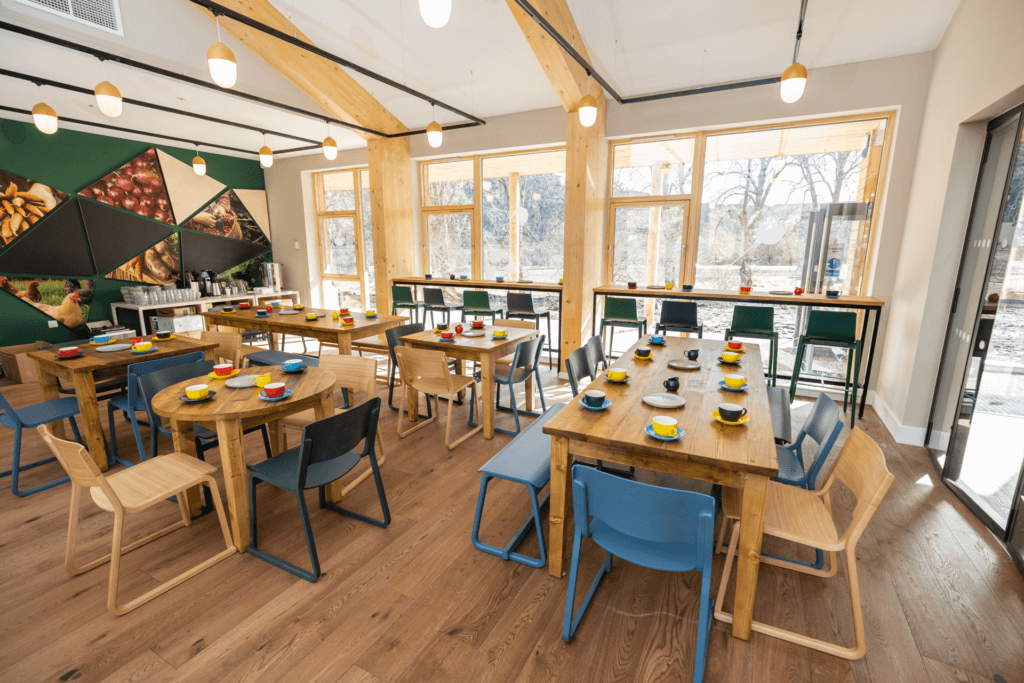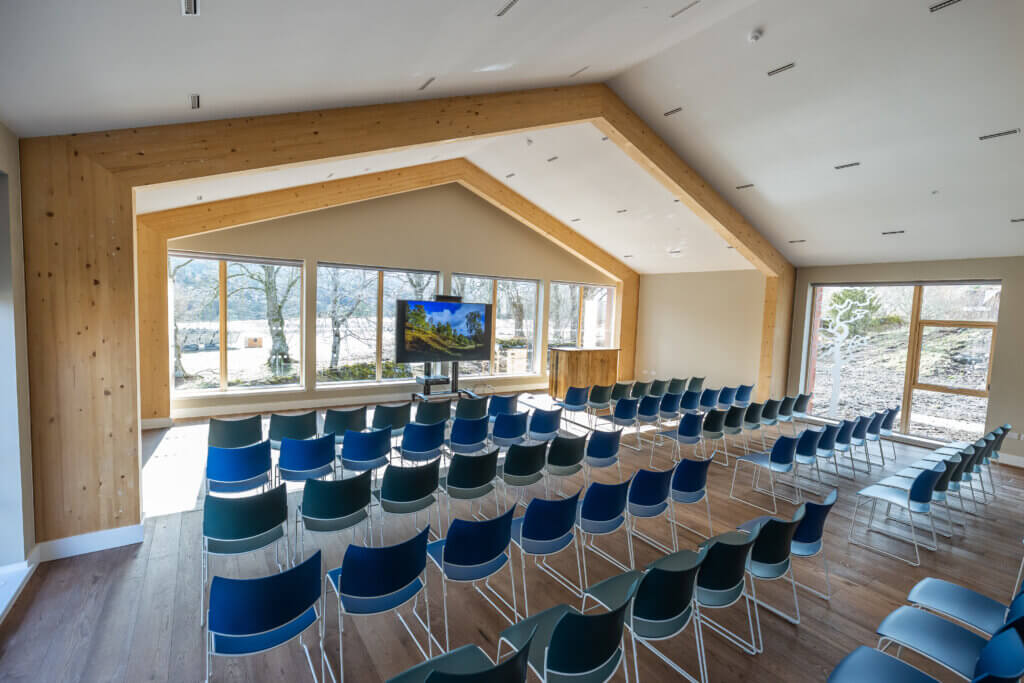World’s first rewilding centre opens near Loch Ness
Centre offers gateway to UK’s largest rewilding landscape, boosting jobs and supporting re-peopling

The world’s first rewilding centre has been opened near Loch Ness in the Scottish Highlands by charity Trees for Life – showcasing how large-scale nature recovery can give people inspiring experiences, create jobs and benefit rural communities.
The Dundreggan Rewilding Centre in Glenmoriston celebrates rewilding and the region’s rich Gaelic culture, and offers a gateway for visitors to explore the 10,000-acre Dundreggan estate, where Trees for Life is restoring the Caledonian forest and its wildlife.
“For 15 years, Dundreggan has been a beacon for rewilding our landscapes. Now it will be a beacon for rewilding people too,” said Steve Micklewright, Trees for Life’s Chief Executive.
“This is a place of hope. We want to breathe life into the huge potential of the Highlands to help nature return in a major way – providing people from all walks of life with fantastic experiences while supporting re-peopling, boosting social and economic opportunities, and tackling the climate and nature emergencies.”
The centre, eight miles from Loch Ness on the main road (A887) to the Isle of Skye, opens its doors fully to the public on Saturday 15 April with a celebratory weekend of special events and activities.

Developed in consultation with the local community, the free-to-access centre has been made possible thanks to the generous support of major funders.
Visitors, families, schools and those with specific needs will be able to enjoy year-round events and experiences, discover how rewilding benefits wildlife such as golden eagles, red squirrels and wood ants, and learn about Gaelic culture and its deep connections to the landscape.
The centre features a stunning tree sculpture of reclaimed metal, created by acclaimed artist Helen Denerley, and offers a gateway to the wild forest, with fully accessible trails, child-friendly forest experiences, and more adventurous walks. Displays in English and Gaelic introduce rewilding and the Gaelic language, and a storytelling bothy showcases local history and heritage.
A café and events space offer locally sourced food and drink and entertainment areas, while a purpose-built and accessible 40-bedroom accommodation building allows people to stay for longer experiences.
Twenty new jobs have already been created, employing local people, and the multi-million pound investment will generate an ongoing economic boost for local suppliers and services. The period of design and construction has already involved local businesses from architects to plumbers.
Laurelin Cummins-Fraser, Dundreggan Rewilding Centre Director, said: “Whether a visitor has just an hour for a quick visit or wants to stay with us for an immersive rewilding experience, our centre will welcome people to discover stunning landscapes, unique wildlife and Gaelic culture, while connecting with the wonders of the natural world.
The Rewilding Centre is embedded in the landscape and the community. Its design is inspired by Gaelic heritage and history, and by the Caledonian forest – with verticals representing trees, changing light to reflect how light plays in woodlands, and materials and colours conjuring up bracken and forest bark. It’s a really special place for people to enjoy.”
Dundreggan is part of Affric Highlands, the UK’s largest rewilding landscape which will potentially cover over 500,000 acres – restoring nature while strengthening land-based livelihoods and creating economic opportunities. Trees for Life launched the Affric Highlands initiative in 2021, in partnership with Rewilding Europe and an initial coalition of communities and landowners.
Funders of Dundreggan Rewilding Centre include the Natural and Cultural Heritage Fund, led by NatureScot and funded through the European Regional Development Fund; National Lottery Heritage Fund; Bòrd na Gàidhlig; Low Carbon Infrastructure Transition Program; SSE Sustainable Development Fund; Audemars Piguet Foundation; Improving Public Access Fund; FERN Community Funds; Fort Augustus Community Council; Highlands & Islands Enterprise; and Garfield Weston Foundation.
Individual donors and investment through the Triodos Bank crowdfunder platform contributed substantial funds.
For more details, see visitdundreggan.co.uk.

Ends
[registration_form]
‘and learn about Gaelic culture and its deep connection to the landscape’ – yeah that’s why much of it is knackered in the first place. Of course we couldn’t just have an educational centre about wildlife, millions of years of evolution, ecosystem development, its destruction and its restoration, no the Gaelic mafia has to get its slice of the action flag waving for Gaels Inc. Technically and morally nature should’ve been the front, back and centre of it all, that we’ve got to start accommodating it rather than its got to accommodate arrogant us. Fat chance that was ever going to be allowed to happen on ‘their’ turf, not going to be second fiddle for anybody/anything, not for a second.
Will this centre mention that the last known great auk in British waters was kicked to death by three St Kildans because they thought through its witchcraft it had kept a storm going for three days? Oh those salt of the earth olde folk of the soil with their close, nay magical connection to nature which us crap townies nowadays can only wonder at!!!
Then there are the lovely crofters on the Gairloch peninsula who when sea eagles returned claimed they were gobbling up hundreds and hundreds of lambs – my, my what greedy eagles!!! When SNH rushed to fit radio collars to 58 live lambs there to get to the bottom of this – because when the Gaelic mafia say “Jump!” Scottish politicians say “How high?” – not one…not one…lamb was touched by an eagle talon. Well fancy that! Having the rug pulled from under them like that was responded to by claims that the radio collars deterred the eagles, there had been discrete supplementary feeding or the naughty birds had been secretly captured and moved elsewhere by those sneaky conservation folk. This utter embarrassment is slipping out of recent memory so they’re now on the second attempt ramping up claims about sea eagles making sheep farming on the west coast uneconomic….hasn’t it been for years, but if you can call for compensation?
Can anyone recall an example of where the Gaelic community initiated and developed a conservation project itself? Me neither. Have any crofting/Gaelic representative bodies ever came forward with a public statement deploring the illegal persecution of Scotland’s birds of prey? Silly me of course not, that would mean something else apart from them was the victim. Occasions though when a new conservation project has been announced and the response “animals were more important than people” to us non Gael lot and the money should be going to locals instead.
A couple of years back Sir Tom Devine, widely regarded as Scotland’s pre eminent historian, wrote ‘Clearances’. He received some pretty strong criticism from certain quarters for having the temerity of pointing out that the clearances didn’t just happen in the Highlands they happened right across rural Scotland (and don’t forget what happened in England with the Enclosure Acts) hence why the book wasn’t entitled ‘The Highland Clearances’. If you try to appropriate what supposedly was done to your ancestors hundreds of years ago as a special level of oppression that somehow allows you to play the victim card today then it’s a bit of a pisser when it’s made clear that it was pretty much the bulk of the people everywhere that got the same treatment – you’re not special (you never were). Not only was I not shocked at this, I’d been expecting it, so bloody predictable. This is why my stomach turned when I first heard about the plans for this centre and the inclusion of ‘Gaelicness’ was highlighted – it’s down to shoddy rural politics, keeping the same people happy who tried to give Tom Devine a hard time. Throwing them a rather big bone
Imagine a similar initiative in another locality such as parts of the East Midlands where wildlife has been hammered too and being told a significant part of it would be exploring the local people’s connection to the land, tales, culture…a desperately needed opportunity for conservation and explaining its relevance for people watered down and compromised so it can be part folk museum? As far as I’m aware you don’t get this at Minsmere or Knepp, but this centre being where it is at Dundreggan this was practically obligatory – not the Gaels helping to push ecological restoration, ecological restoration part hijacked to push the Gaels and there is a difference. A long grumble even by my standards, but if you’d actually had dealings with crofters as I have you’d understand.
When does the legitimate expression of a grievance with a group of people of a particular cultural or ethnic identity cross a line to meet with the ugly language of racism? To approach an answer we could take this comment from Les Wallace, strike out the references to ‘Gaels’, ‘Gaelic’ and ‘crofters’, and replace them with ‘Jews’, ‘Jewish’ or ‘immigrants’. Or ‘Moslems’, or ‘black people’. Take your pick. Try it, and see what you think. I did.
What I know Steve is a lot more important to me than what you think – it helps if you acknowledge experience and context BTW. Gaels aren’t a race although some are rather tediously trying to obtain official ‘ethnic’ status to put them on a level with say the Sami in northern Scandinavia, more a group of people who’ve assumed an attitude and mindset based on where they happen to have been born and raised – it’s a label they choose for themselves as opposed to people there who just live their lives being people without affectations. The people of Fort William I worked with could have beaten the same drum those on Lewis did, but they didn’t they were delightful and hospitable and truly needed help whereas those on Lewis were very well off, but wanted more and more and more.
FYI a while back I approached the Wildlife Trusts to very strongly urge them to proactively make a public statement discrediting the practice of certain right wing groups comparing the effect of non native, invasive species on our native wildlife with ‘non British’ i.e refugees, immigrants and non white people (even if they’ve been born and raised here) with the ‘native’ human population. This was instigated by a particularly repellent outfit called Patriotic Alternative whose stated ‘conservation policy’ predictably emphasised the problems caused by non native species and used that as an analogy for ‘non British’ people and the British (the real white ones according to them). This even extended into anti Semitism by saying that it was global trade carried out by a certain ethnic group that was behind moving species around. Truly pathetic and disgusting and the WTs really need go on offence dealing with this tripe where a genuine conservation concern has been misappropriated to be used in actual racism.
In my time I was an Anti Apartheid campaigner, I’ve helped send supplies to the immigrant camp that was at Calais, did a wee spot of voluntary work to help Syrian refugees settle in my home town and as a life time admirer of Jewish culture I applied to become a volunteer for the Campaign Against Anti-Semitism. With frustration and disappointment I dropped out of that when I saw the organisation was using the label ‘anti Semitic’ on anyone/anything critical of Israeli state policy. I’m not a racist and detest any lack of humanity – for instance the fact that national organisations have generously donated to create play parks on Lewis, but the local wee frees (Presbyterians) have strenuously banned children from using them on a Sunday. Starting to get the picture why I’m so angry?
I didn’t invent the term Gaelic mafia, that a form of cultural blackmail is being used (and I’ve witnessed this) is well recognised, but unfortunately next to no one is prepared to speak openly because of the likely censure you’ll receive for doing so – validating the term. At the age of forty two in the space of thirty six hours I went from being excited at the prospect of finally meeting all those struggling, but hospitable crofting folk I’d heard such lovely things about to being disgusted at the widespread avariciousness I experienced among people who weren’t at all struggling very much the opposite, even the people in Stornoway would admit ‘the crofters get everything’.
As a central belt Scot I realised I’d spent decades being deliberately sold a lie, while other people and their families were in genuine hardship and being effectively ignored. What was actually a politically pampered group were having public money thrown at them, but they wanted more and showed little/no sign of caring about anybody/anything beyond their own self interest and playing the victim card to keep the readies rolling in.
That’s why I was so angry when I heard that the TfL centre was going to devote so much of itself to ‘Gaelic culture’, are the people around Knepp any less connected to the land, are their tales less relevant than people who live in the Highlands and Islands? Would a rewilding centre at Knepp feel obliged to give these issues as much prominence as they have at Dundreggan? I very much doubt it. This is really a marketing exercise, a rose tinted package that’s being sold to us and a bowing of the head to the Gaelic mafia – it goes with the territory. In the subsequent days, months and years to that initial thirty six hours where reality painfully displaced decades of the spoon fed pap I’d got from tv and radio my views have only been reinforced. I wasn’t lying when I said I knew Tom Devine would get a lot of stick for pointing out the clearances didn’t just happen in the Highlands.
Trying to articulate all of this to people without direct, personal experience of it is really difficult and potentially contentious, but the outrageous sense of entitlement in Gaeldom means it really has to be challenged. There’s quite a few people who’ve experienced what I did and feel exactly the same, but the silence from them is deafening compared to the calls to cull sea eagles or for yet another grant, rebate or compensation from you know who.
So I suggest that the moral of this discourse, Les, is that words are powerful, and we need to be careful and moderate in our use of them, lest our noble intentions be misunderstood.